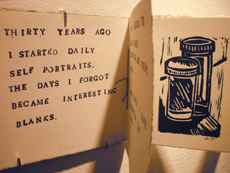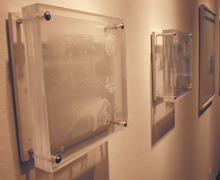For those who might be inclined to think of art professors as stuffy academicians more familiar with the slide projector than the paintbrush, the Faculty Show on view at the Harbor Gallery from October 9 through November 6 provides a pleasant argument to the contrary.
Featuring works by five UMB professors, the exhibit shows that the art faculty here on campus does not just teach the theory and history of art, they live it. Through a variety of mediums, from traditional forms like oil painting to contemporary concepts like light boxes, these five art professors reveal that they, much like their own students, are passionate, working, growing artists still engaged in the process of experiment and discovery.
Take Ann Torke’s Daytime TV, for example. Described by the artist as “a series of sculptural gestures”, the experimental project, which escapes the conventions of both sculpture and drawing while maintaining the qualities of each, is as much concept as it is object.
The project consists of three of these “sculptural gestures”, each made of an approximately 65 foot long list of information from television commercials printed on clear acetate and affixed to an open-reel tape measure. Each one of these lists can be “unwound to read the length of one day’s span of commercials.” Hung on the wall and arranged in sloping designs, the pieces achieve a unique balance between three dimensional sculpture and simple line drawings, between abstraction and social commentary.
From a distance, the works resemble fishing lines, made of advertisements designed to reel the buyer in. The text itself reads like an endless consumerist mantra. The reductio ad absurdum of the list, where one product jingle runs without accent into another, renders the text and, by association, its original purpose meaningless. Its coercive power becomes little more than a nonsense poem, a hypnotic lullaby for the over-stimulated shopper. It’s an interesting idea worked out in an original form that points to a commitment to finding new ways of artistic expression in a media-saturated culture.
Much the same could be said of the work of Margaret Wagner, whose non-traditional combinations of media also result in works that blend the aesthetic with the social. Works like Relational Coiling and Spontaneous Mutation, made of wood boxes with translucent colored plastic fronts through which electric lights glow and fade, create a tension between static line etchings and kinetic light sources, a dialogue between art and technology. A piece like Mis-Translation XOX, for example, reminds one as much of one of Mark Rothko’s color fields as of a traffic light. Other works, like Wagner’s two untitled pieces made with clear plexi-glass, achieve tension through a layering of etched images on clear plastic where each successive layer seems to struggle for dominance. The works are bold combinations of traditional art techniques with modern, industrial materials. As the artist states, “these works explore the interior and the exterior, and what’s caught in between. They utilize/appropriate imagery from the biotechnology and communications industries as a way to depict the most invasive and fascinating forms of seeing.”
The photos and prints of Melissa Shook reflect a turn from the social toward the personal. Confidential and autobiographical, Shook’s black and white photo documents of her living spaces (accompanied by brief text explanations that read like diary excerpts) are compelling investigations of the self as art. This delicate balance of the exhibitionistic and the introspective is best exemplified by Twelve Hours, a book of lino-cut prints, composed of still lifes and semi-abstract images, which, like the naked body of a lover or the confidences of a friend, trusts the viewer to respond to its intimacy with tenderness. Spread against the wall under lights, with its pages invitingly splayed, the work is a metaphor for the flux of memory, the self laid bare. Graphically, it is a lovely collection of images; emotionally, it is honest and complex.
Less openly emotional, the works of Wilfredo Chiesa are studies in tightly controlled abstraction. Working in the traditional mediums of painting and drawing, Chiesa’s innovation lies in his use of strict geometric patterns and monochromatic color schemes to produce dramatic tension.
The drawings in the series, Augen Weide, are like Mondrian minus the color. Using simple squares and subtle shadings, these works in graphite, charcoal and pastel force the viewer into an exercise in asceticism where beauty is simple, static, and direct. The works are like a closed door, through which the complexity of thought and feeling are but minimally intimated through the purest of forms. Chiesa’s oil painting, Arcos 87, is similar in effect. Here a central architectural shape focuses the eye while the daring interplay of blacks and whites redirects attention so that the viewer becomes caught in the tension of form. An intellectually challenging painter, Chiesa seems to be the most consciously academic artist on display here. Yet his work is anything but stale; a curious energy emerges from his rigorous structures.
One highlight of the show is Elizabeth Marran’s Trust Me, a collection of twenty black and white photo etched images. According to the artist’s statement, “each image presents a…story whose inter-relationships imply an overall narrative.” Each image consists of a surreal, cartoonish graphic (reminiscent of the comic book images of Lichtenstein) paired with a cryptic title that furthers the narrative direction while developing symbolic power through the tension of image and text. The work is a dynamic examination of the play of meaning between sign and signified and the psychological function of metaphor.
The digital prints in Marran’s The Nitpicker Series continue the theme of cross-referential imagery. As the artist states, “the work explores the perfect and the imperfect, the controlled and the accidental.” Marran’s work is visually engaging as well as thought provoking; it encourages the viewer to think about the way in which one interprets images.
The Faculty Show opened with a well-attended public celebration and will close with a similar celebration to which the UMB community is also invited. In the meantime, the Harbor Gallery will be open to all who are interested in finding out for themselves that the members of the UMB art faculty are not just serious and dedicated teachers of art, but serious and dedicated artists as well.
Untitled, by Margaret Wagner






















































